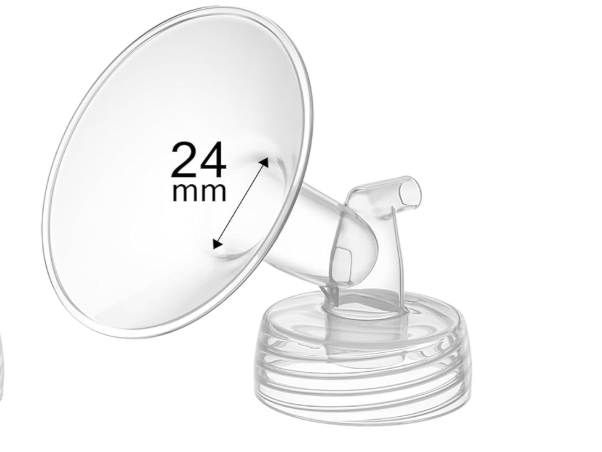Flange Styles: Features, Benefits, and How to Choose
I get asked all the time- why can’t I just buy a sizing kit and order my size? It’s just not that simple, your breast shape and the elasticity of your breast tissue comes into play here… Plus, maybe lefty nipple is bigger than righty nipple! Your boobs deserve the right size.
The truth is… using the right flange can make a huge difference in your pumping comfort and milk output. At Be Well Baby, we use Maymom flanges because they have the most size and shape options out there! Our favorite styles are Crater and Pano, but they also have the Classic and Comfy (which for most people I’ve been seeing recently isn’t actually comfy at all)—and I’m breaking down what makes each one special, who they might work best for, and how we help people figure out the perfect fit.
Pro tip: unfortunately… the silicone flanges and silicone flange inserts don’t actually tend to be that comfortable, and they tend to decrease milk output over time!! I wish they worked- and they DO for some bodies… but these are the ones that we get the best results from.
1. Crater Flange
Material: Hard plastic
Comfort: Usually the most comfortable! — it’s firm but offers good alignment
Design: A shallow, dish-like shape at the base
Why it matters: This shape helps reduce areola pulling and centers your nipple in the tunnel better
Suction feel: Firm and consistent thanks to the rigid material
Best if you:
Notice areola discomfort or pulling
Need better nipple centering
Like a more “traditional” suction feel
2. Pano Flange
Material: Hard plastic body with a soft silicone rim
Comfort: High — the angle is perfect for some breasts! combines solid support with soft, gentle contact
Design:
Angled tunnel (105°) so you can pump more upright and comfy
Oval-shaped opening that can rotate to match your breast shape better
Soft silicone edge that cushions and seals gently
Why it matters: Supports natural nipple alignment, helps prevent neck/back strain
Suction feel: Balanced — soft where it counts, strong where you want it
Best if you:
Have elastic nipples that need gentle handling
Experience neck or back tension while pumping
Want more anatomical comfort and posture support
3. Classic Flange
Material: Hard plastic
Comfort: Honestly, lower — it’s less forgiving on sensitive or elastic nipples
Design: Traditional straight tunnel, smooth and simple
Why it matters: This is based on older pump designs, so it feels very familiar
Suction feel: Firm, but many find it rigid or uncomfortable
Best if you:
Aren’t having discomfort with the flanges you already have!
Really want that classic pump feel, or have no other options
Heads up: We hardly ever use the Classic flange because it’s just not that comfortable compared to Crater or Pano. The old-school “pump feel” can be harsh, and most people prefer the anatomical design and softness those other flanges provide.
4. Comfy Flange
Material: Soft silicone rim with hard plastic inside (two pieces)
Comfort: Supposedly high? I mean, the name IS comfy. But like I said, we don’t tend to use these very often!
Design: Smooth, flexible tunnel with a gentle suction feel
Why it matters: The larger silicone edge can be more comfortable during engorgement (though we don’t really see a difference in our practice!)
Best if you:
Are curious and want to try all the things because you can’t find anything that works!
Want a super gentle pumping experience
How We Size Flanges
When our team helps people find the right flange, we do a quick “rapid test.” This means we swap out different flange styles and sizes often during a pumping session, paying close attention to comfort and milk output. This hands-on approach helps find the best fit — because everyone’s anatomy and preferences are unique! And each breast is unique!
And here’s what the latest research is showing:
📖 A 2024 study in the Journal of Human Lactation compared traditional sizing to a newer, more precise method. It found that smaller flanges (13–19 mm) often worked better than the older “standard” sizes (21–24 mm) for both comfort and milk output.
This supports what many lactation consultants have noticed in practice: most people do best with a flange smaller than they think they need.
The takeaway
Fit matters — a lot. The right flange size and style can make pumping feel more comfortable, protect your nipples, and even boost how much milk you’re able to express.
So don’t be surprised if your “perfect” size is actually much smaller than you imagined — and don’t be afraid to test out different options until you find your match.
Remember, your flange choice is personal. Think about your nipple shape, how sensitive your skin is, and what feels good. With the right fit, pumping can feel so much better.
Love,
Emily




